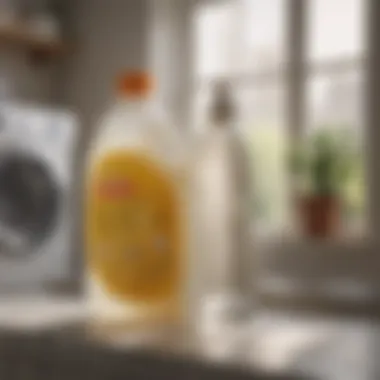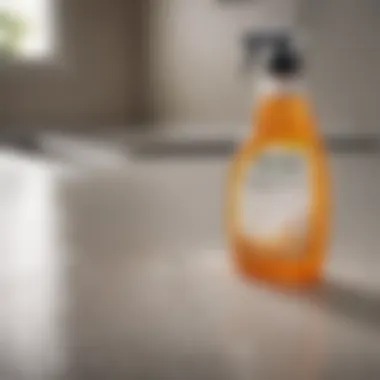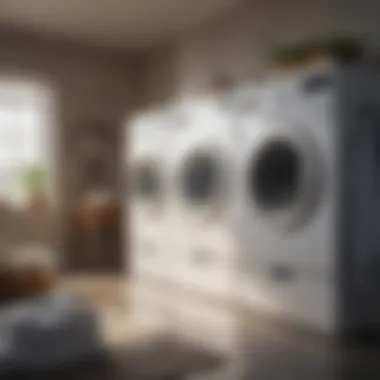Exploring Borax: Its Role in Effective Laundry Practices


Intro
In the world of laundry, many folks might only think about detergent or fabric softener. This article aims to change that mindset, shining a light on borax, an often-overlooked powerhouse. Originally used in households well before the modern cleaning products came to be, borax has a rich history and a myriad of benefits. It's not just a relic of the past but a versatile cleaning agent that rises to the occasion even today. Whether you're tackling stubborn stains or enhancing the freshness of your fabrics, borax offers a multitude of applications that can transform your laundry experiences.
As we journey through this discussion, it’s key to understand how borax operates on a scientific level, its eco-friendly advantages, and practical tips for integrating it into everyday laundry routines. This isn’t just about the process; it’s about making informed choices that not only clean our clothes but also consider our environment. Let's dig deeper into the current trends shaping our cleaning methods, especially with regards to natural and sustainable practices.
Understanding Borax
A solid grasp of borax is fundamental to appreciating its role in laundry practices. Understanding what borax is, how it’s historically been used, and its chemical properties unveils why it’s still a mainstay in many households today. Many people look for natural alternatives for cleaning, and borax fits the bill well. It shines as not just a cleaning agent, but also as a versatile helper for various laundering tasks. By familiarizing oneself with borax, one can unlock its full potential for effective laundry care, enhancing both cleaning results and fabric longevity.
What is Borax?
Borax, scientifically known as sodium borate, is a naturally occurring mineral. Found in arid regions like California, it’s mined for its numerous uses. In laundry, borax acts as a natural cleaning booster. When mixed with water, it forms a solution that helps lift stains, breaks down dirt, and tackles odors. It’s particularly beneficial when dealing with hard water, helping to soften it and enabling detergents to work better. Despite being a well-known substance for many ages, it’s remarkable how effective and safe it can be, especially in a time when folks are leaning towards eco-friendly options.
Historical Use of Borax
Historically, borax has played a vital role straddling different industries, but its laundry use stands out. Since ancient times, cultures have harnessed borax for its cleaning prowess, from the ancient Egyptians who used it in mummification to the Chinese who realized its potential as a cleaning agent in textiles. By the late 19th century, it found its way into American homes, marketed as a laundry booster. Users touted its ability to brighten whites and keep colors vibrant, a practice that has carried through to modern laundry routines. The journey of borax from ancient applications to its current status highlights its enduring efficacy and the trust that people have in this simple yet powerful mineral.
Chemical Composition and Properties
Diving into the chemistry, borax comprises sodium, boron, oxygen, and water molecules. Its formula is often represented as Na2B4O7·10O, showing that it is a hydrated salt. Its structure is interesting too; borax contains borate ions which contribute to its mild alkalinity. This quality enhances its effectiveness in breaking down acidic stains like tomato juice or red wine. Additionally, being slightly abrasive, borax can help in scrubbing without being harsh on fabrics. The low toxicity levels make it a popular choice for households aiming for a safer alternative while maintaining cleanliness. In sum, the chemical properties of borax not only make it versatile, but also an effective option for those keen on natural cleaning solutions.
Borax in Laundry: An Overview
The many benefits of borax in laundry practices can’t be overlooked in today’s fast-paced cleaning routines. Not only does it serve as a powerful ally in the battle against stubborn stains, but it also champions the cause of fabric maintenance, odour neutralization, and overall cleanliness. Understanding borax's role in laundry provides a valuable perspective for those who seek effective and sustainable cleaning methods.
Why Use Borax in Laundry?
Using borax in laundry offers a range of advantages. It’s not just a mere additive; it plays a starring role in enhancing the cleaning process. Here are some reasons why you might consider incorporating it into your washing routine:
- Stain Fighting Power: Borax is renowned for its stain-fighting capabilities, helping to break down organic stains like grass and blood.
- Enhancement of Other Cleaners: When added to other detergents, borax enhances their effectiveness. It complements the cleaning action of soaps and detergents, making them work harder.
- Water Softening Ability: Hard water can significantly reduce the effectiveness of detergents. Borax softens water, ensuring that your laundry detergent lives up to its promised performance.
- Odor Control: Borax neutralizes bad odors and leaves clothes smelling fresher. This quality can be especially beneficial for items like sportswear or gym bags that often harbor unpleasant smells.
Comparing Borax to Commercial Detergents
When stacked against commercial detergents, borax might seem like an underdog. However, it brings unique benefits that deserve attention. Some contrasting points to consider include:
- Cost-Effectiveness:
- Natural Ingredient:
- Multi-Functional:
- Fewer Skin Irritants:
- Borax is typically less expensive compared to many ready-made detergents. A little goes a long way, making it a budget-friendly option.


- Many commercial detergents are filled with synthetic chemicals, while borax is a naturally occurring mineral. This can be particularly appealing to those looking for greener cleaning alternatives.
- While detergents often serve one primary purpose, borax can be used in various ways: from laundry to cleaning surfaces to even pest control in the garden.
- Some people experience skin sensitivities from the harsh chemicals in commercial detergents. Borax might provide a gentler alternative for certain users.
Applications of Borax in Laundry
Borax, a mineral that has stood the test of time, has gained popularity not just for its diverse cleaning properties but also as a sustainable alternative in laundry practices. When it comes to doing laundry, knowing how to make the best use of Borax can yield significant benefits. From fighting stains to softening fabrics, it proves to be an indispensable resource for both regular housekeepers and those embarking on ambitious laundry endeavors. Its applications cover a wide range of benefits, making it an essential topic in the realm of eco-friendly and effective laundry solutions.
Stain Removal
Types of Stains
In the laundry lexicon, stains are a common nemesis that seem to have a knack for appearing at the worst possible moment. Understanding the types of stains—greasy, protein-based, tannin-based, and dye stains—can illuminate how Borax can combat these unwelcome marks. Each stain type poses its own unique challenges. For example, grease stains from cooking oil are stubborn due to the oily compounds they contain, while tannin stains, like those from red wine, cling to fabrics resolutely.
Using Borax can be especially advantageous in these situations, as its alkaline nature helps to break down not only grease but also the compounds found in protein and tannin stains. Many people turn to Borax for stain removal due to its effectiveness as a natural solution, steering away from abrasive chemicals. Its unique feature lies in its ability to react with stains at the molecular level, which means not just covering up but actually addressing the issue. However, while Borax shines as a stain remover, it's important to remember that certain fabric types, like silk, may not respond kindly to such treatments, requiring a more gentle approach.
Methods of Application
When it comes to applying Borax for maximum stain-fighting prowess, techniques vary significantly. Pre-soaking is one method that many find particularly effective. Soaking clothes in a solution of Borax and warm water can give the mineral time to work its magic before washing. This method ensures that the particles penetrate deep into fibers, attacking the stain rather than simply moving it around.
Another method involves adding Borax directly to the wash cycle along with your regular detergent. This not only enhances the detergent's performance but also acts as a buffer against colors bleeding. The key feature of this application is its dual action: it boosts stain removal while being gentle on clothing. However, it's wise to avoid overuse, as too much Borax can lead to residue buildup, which may leave clothing feeling gritty if not rinsed out properly.
Softening Fabrics
Borax also excels as a fabric softener. Hard water can wreak havoc on cloth, leaving it feeling stiff and scratchy. By incorporating Borax into your laundry routine, you provide a solution to this issue. Its ability to alter the pH of water helps dissolve mineral deposits that can cause fabric stiffness. As a result, clothes washed with Borax have the potential to feel noticeably softer.
In addition, Borax can aid in preserving the color of your clothing. When fabric feels soft, it’s not just a matter of comfort but also about the longevity of clothing fibers. Using Borax in this way reflects its multifunctionality, allowing you to enjoy soft, vibrant garments with minimal effort.
Odor Neutralization
Last but not least, odor neutralization is yet another noteworthy benefit of Borax in laundry applications. We’ve all faced the frustration of washing clothes only for lingering odors to persist. Borax acts as an odor absorber, neutralizing smells trapped in fabrics. Whether it's that musty scent from towels or the stubborn smell of sweat on gym wear, adding Borax to your wash can make a world of difference.
Many housekeepers swear by Borax for its ability to tackle pungent odors without the need for synthetic fragrance. Instead of masking the smell, it cleanses the fabric itself, providing lasting freshness.
"Borax helps tackle odors at their source, rather than just whimsically covering them up with more scent."
In summary, the diverse applications of Borax extend beyond mere laundry; they embrace an eco-friendly approach that marries effectiveness with sustainability. By leveraging its stain-fighting power, fabric-softening capabilities, and odor-neutralizing properties, housekeepers can transform their laundry experience, making it not just a chore, but a thoughtful practice centered around care for both clothing and the environment.


How to Use Borax in Laundry
Understanding how to effectively use borax in laundry practices is crucial for harnessing its full potential as a cleaning agent. Many households are turning to borax as a natural alternative to commercial detergents, and knowing its applications can greatly enhance laundry outcomes. This section offers a detailed look at dosage recommendations, combinations with other detergents, and effective pre-soaking techniques, ensuring you make the most of this versatile substance.
Dosage Recommendations
When it comes to dosaging borax, it's key to follow some general guidelines to avoid wastage and achieve optimal cleaning results. For an average laundry load, adding half a cup of borax to your washing machine can significantly boost the cleaning power of your regular washing detergent—a simple yet effective trick.
For heavily soiled items, you might increase that dosage to three-quarters of a cup. However, it is wise to check the washing machine manual or fabric care labels for specific recommendations.
Tip: If you have hard water, which can diminish cleaning effectiveness, increasing the borax amount slightly can help mitigate this issue, enhancing the detergent's performance.
Combining Borax with Other Detergents
Knowing how to combine borax with traditional detergents can amplify your laundry’s cleaning efficiency. Borax acts as a booster, enhanceing the performance of standard laundry materials. It's generally best to add borax along with your regular detergent. When mixing them, two tablespoons of detergent alongside half a cup of borax works wonders for normal loads. For tougher stains, consider using a liquid detergent that complements borax's properties.
Surprisingly, borax interacts well with natural soap as well. A combination of natural soap and borax can create a powerful, eco-friendly cleaning solution, especially appealing to those concerned with environmental impact. Bear in mind that not all detergents are compatible. For instance, avoid using borax with certain specialty detergents without consulting the labels, as it may lead to subpar results.
Pre-Soaking Techniques
Pre-soaking with borax is particularly effective for dealing with stubborn stains. This technique helps loosen dirt and grime before the main wash. To utilize this method, dissolve a quarter cup of borax in a half bucket of warm water. Soak the soiled items for at least 30 minutes—but for particularly tough stains, soaking for a few hours can yield better results.
Once soaked, proceed with your regular washing process. This method not only enhances stain removal but also assists in softening fabrics, reducing the need for fabric softeners. It's a win-win—clean clothes without the harsh chemicals found in many commercial alternatives.
By exploring these practices, you gain insight into effective applications of borax in the laundry room, paving the way to cleaner, fresher-smelling clothes while being gentler on the environment.
Safety and Environmental Considerations
When it comes to using borax in laundry practices, understanding the safety and environmental implications is crucial. As more people embrace eco-friendly cleaning options, safe usage of borax can not be overlooked. This section aims to elucidate the essential precautions to take while also considering the broader environmental impact of borax.
Safety Precautions When Using Borax
Using borax may seem straightforward, but there are some vital safety guidelines to keep in mind. Here are the key precautions:
- Keep Out of Reach of Children: Borax can be harmful if ingested. Store it in a secure location, away from little hands.
- Wear Gloves: While borax is relatively safe, direct contact with the skin can cause irritation. Protect your hands with gloves when handling the powder.
- Avoid Inhalation: When pouring borax, do so carefully to prevent breathing in any dust particles. Consider wearing a mask if you're sensitive to dust.
- Dilute Before Use: If you’re mixing borax with other solutions, always dilute it first. This practice minimizes potential skin irritation and enhances cleaning efficacy.
- Check Labels: If you plan to combine borax with other cleaning agents, ensure that they are compatible. Some chemical combinations can produce toxic reactions, so sticking to reliable sources of information is essential.
Following these precautions allows you to make the most of borax’s benefits while ensuring your safety and that of your household.
Environmental Impact of Borax


Borax isn’t just a powerhouse in your laundry; it’s also worth noting how it interacts with the environment. Despite being a natural mineral, there are considerations:
- Biodegradability: Borax is biodegradable, meaning that it breaks down naturally and doesn’t linger in the environment. This benefit makes it a better choice than many synthetic detergents that can accumulate in ecosystems.
- Water Impact: When used correctly, borax poses minimal harm to local water supplies. However, excessive amounts can lead to higher levels of boron, which may affect aquatic life. Thus, it’s prudent to use borax judiciously.
- Natural Source: This mineral is sourced from the earth, and while mining can have environmental repercussions, in small-scale household use, borax is largely sustainable and requires less processing than many cleaning chemicals.
- pH Balance: Borax helps maintain the pH balance in laundry, which indirectly supports the longevity of clothing and other fabrics. By extending the life of your possessions, you’re reducing the overall demand for new textiles, hence lessening environmental impact.
In a world where eco-consciousness is needed, using borax thoughtfully signifies a step toward responsible cleaning. It combines effectiveness with safety, creating a pathway for sustainable practices in everyday life.
"With careful usage, borax offers a myriad of benefits, supporting both household cleanliness and environmental health."
By integrating these safety measures and considering borax’s ecological footprint, one can enjoy the myriad benefits this natural agent provides while ensuring a greener, safer home.
Alternatives to Borax
Exploring alternative cleaning agents is crucial in today's world, marked by a growing awareness of both health and environmental issues. While borax has held a prominent place in laundry practices, understanding and utilizing alternatives can provide a well-rounded approach to effective cleaning. The aim here is not to disparage borax but to recognize that a variety of options exist that may suit different needs or preferences.
Natural Alternatives
Natural alternatives to borax often harness the power of everyday kitchen staples or plant-based ingredients, which are less likely to cause skin irritation and are eco-friendly. Here are a few options:
- Baking Soda: Not just for baking, this fine white powder can act as a deodorizer and stain remover. Its mild abrasiveness helps lift stains without harming fabrics.
- White Vinegar: A staple in many households, vinegar works wonders in breaking down mineral buildup and also has antibacterial properties. Adding it to your wash can help rinse out detergent residues and leave fabrics fresh.
- Lemon Juice: With its natural bleaching properties, lemon juice can tackle stains, particularly on white fabrics. Its acidic nature aids in brightening clothes and neutralizing odors.
Using these natural cleaning agents not only ensures safety for families but also alleviates environmental concerns associated with chemical cleaners. Making the switch to such alternatives is as simple as having them handy in the pantry.
Commercial Alternatives
On the commercial front, various products are stepping into the spotlight as viable substitutes for borax. These products often tout similar benefits, striving for a balance between effective cleaning and user safety. Below are some noteworthy options:
- OxyClean Stain Remover: This powerhouse uses hydrogen peroxide in its formulation to break down stains at the molecular level, making it effective for an array of messes on fabric.
- Seventh Generation Laundry Detergent: Known for its commitment to natural ingredients, Seventh Generation offers a range of products that are free from synthetic dyes and fragrances. They focus on plant-based formulation, making it safer for both your home and the planet.
- Mrs. Meyer's Clean Day Laundry Detergent: With charming scents and a commitment to sustainability, this detergent uses essential oils and plant-derived ingredients, giving a gentle yet efficient cleaning experience.
These commercial alternatives not only provide options for those who prefer ready-made solutions but also consider the health of both users and the environment. However, it's wise to scrutinize the ingredient lists, as not all commercial products will meet everyone's safety and ecological standards.
Incorporating these alternatives into everyday laundry practices not only broadens the scope of cleaning opportunities but also empowers households to make informed decisions in their cleaning routines. Ultimately, whether leaning towards natural options or commercial products, the goal remains the same: achieving cleanliness without compromising health or the environment.
Closure
The conclusion wraps up the exploration of borax and its diverse applications in laundry practices, solidifying its position as a reliable tool for anyone looking to enhance their cleaning routines. The key lies in its dual capacity as both a cleaning agent and a fabric enhancer. Households can significantly benefit from understanding these aspects, as it provides an eco-friendly alternative to many commercial laundry products.
Borax isn’t merely a historical relic; it proves its worth in the modern household immersing itself in sustainable practices that go beyond just cleaning clothes. Many people tend to underestimate the power of this natural compound. However, its natural stain-fighting abilities and odor-neutralizing properties can refresh not just fabrics but the overall atmosphere of a home.
When considering laundry tools, it’s crucial to weigh the benefits of using borax against potential alternatives. This article has delved into how safe borax is when used correctly and the environmental considerations post-use. It remains vital for consumers to make informed decisions that align with their values, cultures, and lifestyles, especially in a society increasingly leaning towards sustainability.
Ultimately, the discussion around borax in laundry practices serves to highlight its multifaceted nature and necessity in contemporary cleaning regimes. By embracing this option, homeowners can feel good knowing they’re not just cleaning but doing so in a way that’s considerate of both fabric care and environmental impact.
Final Thoughts on Using Borax
In wrapping up, the insights offered about using borax in laundry practices unveil its practical advantages while emphasizing safety, proper usage, and ecological awareness. Engaging with this information arms housewives and homeowners with valuable knowledge�—one that can result in efficient, sustainable laundry habits without the need for chemical-laden commercial alternatives. Not all heroes wear capes, but some certainly rest in humble boxes labeled borax.
Households can confidently incorporate this age-old compound into their routines, witnessing firsthand its cleaning prowess while remaining mindful of what this choice means for the environment. Whether dealing with tough stains or simply trying to keep clothes fresh, borax holds its ground as a steadfast ally in the journey towards laundry mastery.



